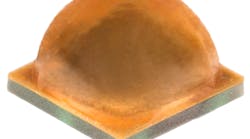Elemental LED’s ANDREW MCALEAVEY says that the SSL industry needs to look beyond a single endurance metric to full design considerations.
Anyone who’s been in the solid-state lighting (SSL) industry for any length of time knows this number: 50,000 hours. When asked about the expected lifetime of an LED, it’s probably the most common answer. It’s also a number that needs a lot of context.
50,000 is such a large number that it’s helpful to translate it into more familiar terms; 50,000 hours is about five years and nine months. Has someone actually lit the LEDs in question continuously for five years and nine months? Maybe. Probably not. Think about it: The LED industry is changing so quickly that by the time someone tested an LED for almost six years, that type of LED would be obsolete.
ANDREW MCALEAVEY
If LEDs are not usually tested for 50,000 continuous hours, how do we get to that number? The answer is a mix of testing and mathematical modeling. The Illuminating Engineering Society (IES) has published standard methods for "endurance testing" of LEDs and for interpreting the data from those tests — most important, standard methods LM-80 and TM-21. In an LM-80 test, LEDs are lit continuously, usually for either 6000 or 10,000 hours, while being "cooked" at high temperature — usually 55°C and 85°C (130°F and 185°F), although hotter temperatures may also be used. Every 1000 hours, the light output and color of the LEDs are recorded.
The result is a few data points, and the rest is math — exponential least-squares curve fitting, to be exact. The light output data is fit to a curve that can be used to predict, for example, when the LEDs will have only 70% of their initial light output (L70). The problem is that these methods generate only 6 data points for a 6000-hour test, and 10 data points for a 10,000-hour test. That’s not a lot of data, and there’s only so far one can take a mathematical projection before it becomes a falsehood. In fact, we say that LEDs have lifetimes of 50,000 or 60,000 hours because that’s about as far out as one can validly project using these methods.
While this kind of endurance testing isn’t useless, it isn’t that useful, either — at least not for most users. The real world is a cacophony of complexities that no laboratory test can fully predict. Obviously, most people don’t install plain LEDs in an oven, as in the laboratory test. Most people install luminaires, finished fixtures that include LEDs along with lots of other parts: printed circuit board (PCB), power conversion circuits or drivers, optical elements, outer casings, diffusers, etc. Strangely, though, even with all those parts that could possibly break, we still fixate on the performance of the LEDs themselves.
We need to alter our thinking. We need to look at the entire luminaire and how we use it. Instead of fixating on 50,000, instead of tossing around terms like LM-80 and TM-21, we should be asking simpler, more holistic questions: How long will this entire luminaire last? What will break first? How can I make the luminaire last as long as possible?
The answers to those questions are both complex and simple. LED lighting can go places and do things that traditional incandescent and fluorescent lighting can’t. It’s trampled weary notions of the possible and been a beacon for the creative. However, LEDs do have limits, and the more that we understand and address those limits, the longer a luminaire will last.
Temperature limits are critical as we squeeze LED luminaires into ever-smaller spaces. Heat melts plastic, overloads drivers, cooks phosphors, and kills LEDs. Unmanaged, it can cause safety problems, both for the unwitting who touch hot surfaces and for the space itself. Yet we sometimes don’t make allowances for the heat that electronic components generate. A little ventilation goes a long way.
Power limits also play a role. A driver loaded to its maximum power output is more likely to fail. Drivers should never be loaded to the cusp of failure, and in extreme environments, they should be de-rated, loaded only to a fraction of their rated maximum load. Good documentation and newer generations of small drivers specifically engineered for LEDs may help.
Using a single number to describe the lifetime of a complex product is simply too reductive. I try every day to provide context, to make others think about the whole fixture. Yet old habits die hard, and old numbers still have their use. Sometimes, when pressed, when nothing else will satisfy, I say it too: 50,000 hours.






